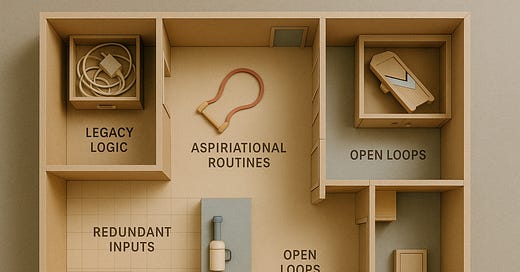Use Case: Clutter
A version history of a drawer (or why our homes still run legacy code)
On offboarding, object logic, and the UX of our physical spaces. Clutter isn’t chaos—it’s a backlog of deprecated identities.
I moved recently. Not far, but far enough to require boxes, tape, decisions.
There is no clearer audit of personal systems than preparing your belongings for transport. Every drawer becomes a confession. The bag of cables you meant to sort, the supplement routine that lasted exactly four pills before becoming furniture, the tote bag that has migrated through five apartments without once fulfilling its constitutional purpose of carrying things. Objects that survived not through merit but through administrative oversight.
Clutter doesn't announce itself with a PowerPoint presentation. It accumulates through a series of momentarily reasonable decisions—mild utility, theoretical future need, the persistent belief that you might suddenly develop an interest in mandolin after watching a single YouTube video at 2am. It becomes the physical manifestation of your browser's 47 open tabs. Every item was once a conscious choice. The question is whether that choice still compiles in your current operating system.
Part I: Offboarding, Absent
Most systems are designed for acquisition, not divestment. Amazon has perfected the one-click buy. There is no one-click "remove this mistake from my life." Software products have entire teams dedicated to onboarding. No one is working on the "graceful exit" experience. The decision tree is asymmetric: getting in requires one tap; getting out requires a support ticket, three emails, and possibly a handwritten letter to the CEO.
Physical objects follow the same protocol. They arrive with unboxing rituals, warranty cards, and aspiration. What they lack is an exit interview. There is no standardized prompt asking whether the person who bought this milk frother still exists, or if they've been replaced by someone who now considers heating milk to be suspiciously European.
Offboarding is treated as edge-case logic. The kind of thing developers implement at 4:45 on a Friday when they'd rather be anywhere else. But in systems that evolve, it should be a primary path.
Part II: The UX of Aspiration
A cluttered apartment isn't evidence of failure. It's a museum of abandoned product roadmaps.
Each object represents a branch in a behavioral decision tree. Not merely "do I use this?" but "was this purchased by a version of me that still gets regular software updates, or has that instance been deprecated?"
The milk frother isn't a device; it's a notification badge in your identity management console. The resistance band isn't exercise equipment; it's a placeholder installed by a Joe Rogan episode that convinced you, for approximately 36 hours, that you were the kind of person who "gets after it." The third identical charger isn't for travel. It's an unresolved exception in your personal risk management framework.
What looks like mess is actually a series of stalled sprints and feature branches that never made it to production. A backlog of selves, eternally stuck in code review.
Part III: The Debug Layer
In software systems, failure states live in log files. In personal environments, they live in the back of the cabinet under the sink.
The drawer you haven't opened since 2019. The box of things you keep because someone might need to borrow a specific size of Allen wrench or your annotated copy of a book you didn't finish but still want people to think you understood. These aren't messes. They're artifacts of mismatched schema.
What you call clutter is often just mislabeled metadata: objects whose purpose was accurate once but now belong to a version of you that has been sunset without proper documentation.
The cognitive dissonance isn't from having too much stuff. It's from running deprecated logic on a system that has silently updated its core functionality.
Part IV: Default States
Clutter is not noise. It is legacy code that still compiles.
If your home is a system, clutter reveals the lag between current state and configuration. The environment still routes resources to abandoned modules. Still provisions for use cases marked "will not fix." Still maintains uptime for identities no longer being actively maintained.
There's no "archive this identity" button in physical space. No push notification when your tea preferences change or your supplement stack collapses under the weight of its own sans-serif branding. But the review is still possible.
Not because you owe order to Marie Kondo or your judgmental friend who somehow lives in an apartment that looks like no one lives there. But because systems perform better when their architecture reflects their actual use.
Most design patterns resist exits. But you are not a captive user. You own the source code.
You can version-control the drawer. You can write your own offboarding flow. You can delete the frother.
What’s your strategy for exiting products - digital or physical? Let’s hear it in the comments.
Thanks for reading Opinions & Conditions May Apply!





